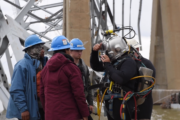BEN FOX
Associated Press
PORT-AU-PRINCE, Haiti (AP) — A shipwreck off northern Haiti may be the remains of Christopher Columbus’ flagship vessel the Santa Maria, an explorer said Tuesday, though experts expressed caution about a discovery that was far from confirmed.
Explorer Barry Clifford said evidence that the wreck is the Santa Maria, which struck ground and foundered on Christmas Day in 1492, includes ballast stones that appear to have come from Spain or Portugal and what looks like a 15th century cannon that was at the site during an initial inspection but has since disappeared.
Clifford, known for discovering a pirate ship off Cape Cod in 1984, said another factor is the location of the wreckage, in about 15 feet of water near where the crew of the Santa Maria is thought to have built a coastal settlement for crew members of the ship who were left behind after the sinking.
“The circumstantial evidence is overwhelming,” Clifford said in a phone interview from his home in Provincetown, Massachusetts. “The cannon is the smoking gun, so to speak.”
He said that he and his son, Brandon, first explored the site and took photos in 2003. They decided to publicize their findings after a follow-up dive and examination of the photos led them to conclude they may have found the Santa Maria. The cannon that they saw in 2003 had vanished by the time they returned last week.
Clifford, whose exploration of the site is being backed by the History Channel, says he has asked the Haitian government to preserve the area around the wreck. “The next step is a careful, thorough and timely excavation,” he said.
Salim Succar, a special adviser to Prime Minister Laurent Lamothe, said the government will do “all that is needed” to protect the site “while deciding on the best options to feature this discovery.”
If the ship is the Santa Maria, it would be the oldest known European shipwreck in the so-called New World and a find of major archaeological significance. But scientists say it’s far too early to make any such declaration especially since there is likely to be very little left of the vessel.
“The evidence, as you can imagine, after more than 500 years is not going to be very much because of time and the environment that the site is in,” said Roger C. Smith, the State Underwater Archaeologist for Florida. “It’s going to require some careful archaeology.”
Smith, who has searched for wrecks of Columbus’ ships in Haiti, the Dominican Republic, Jamaica and Panama, said it’s possible the ship found by Clifford is the Santa Maria, but he noted that there was at least one wreck in that area that was once mistakenly thought to the ship but turned out to be a much later vessel.
Kevin Crisman, director of the Center for Maritime Archaeology and Conservation at Texas A&M University, said many Spanish ships sank off Haiti and the Dominican Republic, and it will be difficult to confirm that this is the Santa Maria.
“Anything is possible in this world, but I would like to see all the evidence, and so far this is not too promising,” Crisman said.
The ship sank slowly in 1492 and the crew had time to strip it and remove valuable items that would help document the identity of the vessel.
Much, if not all, of the ship’s timbers would have broken down or been consumed by a species of wood-consuming mollusk found in the tropical waters — if it hadn’t been carted away by crew members who were left behind and never heard from again.
“If whoever finds the Santa Maria can confirm that it’s the Santa Maria, that’s kind of like the Holy Grail,” Crisman said. “It would be very exciting but I remain skeptical because people make claims all the time.”
Copyright 2014 The Associated Press. All rights reserved. This material may not be published, broadcast, rewritten or redistributed.







